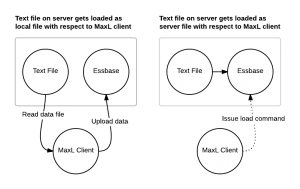Well, here we are again. Birds are singing, the sun is shining, bytes are compiling… and a new Drillbridge point release is out the door. Don’t let the small version bump (from 1.3.2) fool you. This version has seen some significant engineering in the area of performance.
All versions of Drillbridge up to this point (anything 1.3.2 or less) have used a straightforward strategy for getting rows of data into a webpage for the user. In particular, this strategy worked kinda of like this:
Drillbridge: “Hey Mr. Database, can I have these rows that my user wants?”
Database: “Why sure Mr. Drillbridge! Here’s a metric crap ton of rows for you!”
Drillbridge: “Golly, thanks for all the rows of data Mr. Database! I’m going to process through ALL of those and create a formatted version of all of those rows, and then I’m going to hand those off to an HTML template that needs to iterate over all of them and insert them one at a time into the DOM and then pray that the node insertion routine has good performance and…”
Database: “Look kid, you go and play, this bottle of tequila isn’t going to drink itself.”
So, anyway, single page report results have been reworked with performance in mind. In particular, results are processed AS they stream in from the database and are formatted on the fly, then outputted right to the web browser. No more handing off giant table of data (in cases where there were lots of results). Generally speaking, I am seeing page render times that are just slightly above the time it takes to pull the results from the database in the first place.
Drillbridge didn’t really have any problems with smallish result sets but now it pretty easily handles tens of thousands and more.
Additionally, this version of Drillbridge introduces an optional DataTables formatting option as well as server-side paged results. Do read the documentation for implementing results that are paged on the server as there are a couple of steps to set it up. I would consider this feature to be early, but useable. Please let me know if you bump into any issues.
As with before, subsequent releases of Drillbridge will focus on polish, bugfixing, and stability. Future releases will likely slow down as the product matures.
Drillbridge can be found as always in the Saxifrage Systems LLC downloads section. Don’t forget about the support forums, the shiny new Drillbridge wiki, and my upcoming ODTUG Drillbridge webinar on October 28th. It’s more than likely that Drillbridge 1.3.3 will be the version I use for the webinar!
I have tested this version as well as I reasonably can but if you encounter show stopping issues with the database upgrade or usage please let me know and I’ll address that in a quick followup release. So until further notice consider this beta-ish quality.
Happy drilling!
